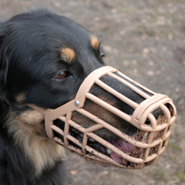Posted: 10 October 2007
Dog-biting attacks as likely inside as outside the home, says new research
The majority of dog-biting attacks in Ireland take place when a person is walking past a dog’s territory (non-owners) or during interactions with the dog in the home (dog owners), according to new research. The study which was presented at a seminar hosted by the UCD School of Agriculture, Food Science and Veterinary Medicine on World Animal Day, Thursday 04 October 2007, also shows that the majority of the victims of dog-biting attacks are aged between 21 and 60.
“Most dog biting attacks are rapid single bites,” explained Edmond O’Sullivan, the author of the report, a full-time veterinary inspector in Cork County Council, who completed the research for his Master of Veterinary Medicine at UCD. “And in 50% of the cases the owner/bite victim was unable to identify any signal of the dog’s intention to bite.”
21% of incidents surveyed in the report were rated as "serious" and 2% were rated as "life threatening.” No life threatening incidents were reported among the owner group. 20% of the dogs involved in incidents were euthanized as a result of the attack.
“50% of the victims of dog biting attacks required professional medical assistance following the attack,” continued O’Sullivan. “And 7% of the owner group and 31% of the non-owner group required hospital A& E and major medical treatment.”
The non-owner group reported more incidents to children less than 5 years old (16% versus 2%) and to children 5-12 years old (18% versus 11%).
“The majority of the dogs involved in the attacks were male dogs between 2-6 years old, over 10kg in body weight and were among the popular breeds of Collies, Cocker/Springer Spaniels, Terrier breeds, Jack Russell Terriers, German Shepherds, and Golden Retrievers,” said O’Sullivan. “And the biting incidents were equally likely to occur in rural and urban/suburban areas.”
According to the study, the bite incidents increased the fear of dogs for victims in both groups. However, non-owner victims were almost twice as likely to develop increased fear of dogs following the incident. 90% of all victims reported that they were not ordinarily afraid of dogs prior to the bite incident.
The incidence of bites from aggressive dogs has increased in frequency and gravity in recent years. However, in Ireland there is no official reporting mechanism for dog bite incidents and specific data on the incidents is not readily available from hospital accident and emergency records.
To conduct the research, O’Sullivan established a dedicated telephone line number: the Dog Bite Line (DBL) The DBL was publicised in newspapers and on radio stations to encourage members of the public who had been bitten by a dog or whose dog had bitten somebody to telephone the DBL and participate in the study.
The study was undertaken to form the basis of a planned public health programme specifically focused on the prevention of dog bites. In order to obtain representative data it was decided that the study would target both the owners of dogs that had bitten a person and the victims of bites inflicted by dogs that were not owned by the victim.
The data used was derived from dog bite incidents in Ireland provided by 100 owners of a dog (owner group) that had bitten a person and by 134 victims of bites by a dog not owned by the victim (non-owner group). The data was obtained by telephone interview of self-selected volunteer dog owners and bite victims between January 2004 and April 2005.
The plenary session at the seminar hosted by the UCD School of Agriculture, Food Science and Veterinary Medicine was presented by Dr Caroline Hewson, an expert in companion animal welfare and a veterinary surgeon. It was sponsored by Veterinary Council of Ireland Education Trust Fund.

